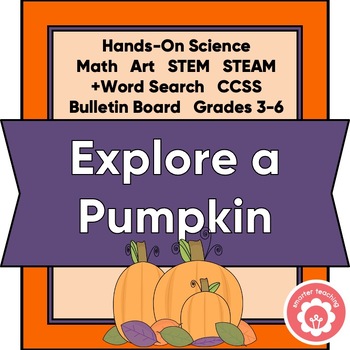Pumpkin Investigation Hands On Science Math and Art STEM CCSS Grades 3-6
- PDF
Also included in
- Make holidays even more special with this Holiday Celebration Bundle, featuring highly engaging academic lessons that are classroom-tested student favorites. Not only will your students look forward to the festivities, but administrators will also appreciate the sophistication of continued learningPrice $70.91Original Price $101.30Save $30.39
- Explore this STEM/STEAM Bundle, featuring seven highly engaging lessons designed to foster critical thinking in grades three and four. Be sure to open the individual previews to see each lesson's unique content, covering a variety of important topics in an easy to implement format. These lessons arePrice $35.46Original Price $50.65Save $15.19
Description
Open the preview to see the pumpkin-themed math and science lesson, perfect for enhancing your autumn, Halloween, or Thanksgiving curriculum. In this lesson, students work in groups to engage in hands-on exploration of pumpkins. This involves making both estimated and actual measurements to uncover insights from the pumpkins' external and internal features.
Key Components of the Investigation Include:
- Weight Measurement: Understanding the mass of different pumpkins.
- Diameter and Circumference: Measuring the size of pumpkins.
- Vertical Lines (Ribs) Study: Analyzing the structure of pumpkin ribs.
- Three-Dimensional Shapes: Identifying shapes that resemble pumpkin forms.
- Seeds and Seed Patterns: Exploring the arrangement and biology of pumpkin seeds.
- Pumpkin Brains: Investigating the fibrous interior of pumpkins.
- Detailed Diagramming: Labeling parts of a pumpkin, both internally and externally.
- Illustrating the Pumpkin Life Cycle: Creating a visual representation of a pumpkin's growth stages.
- Pumpkin Farming Insights: Learning about the agricultural techniques behind growing pumpkins.
- Pumpkin Vocabulary: Building terminology related to pumpkin studies.
- Creative Expression: Imagining life as a pumpkin through drawing and writing activities.
Experience the lively discussions that animate the classroom as students explore the complexities of pumpkin science and math. After completing the studies, engage students further with a themed word search and create a display using the bulletin board lettering "If I Were a Pumpkin."
This comprehensive lesson educates and captivates students providing a deep understanding of a popular fall theme.
Other pumpkin resources you might like:
Pumpkins: Fictional Narrative Writing
My Pumpkin Book Study: Grades 1-3 STEM
Just click to follow this store for updates. You'll be the first to know about new items - all posted at a 50% discount for 48 hours.







